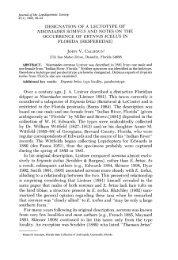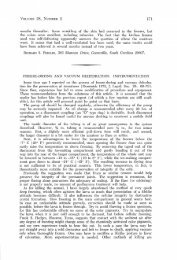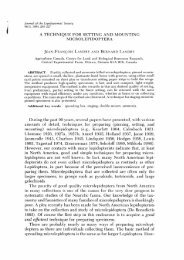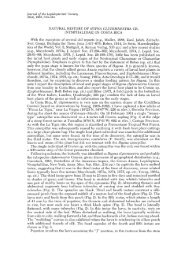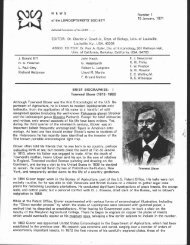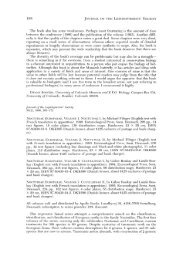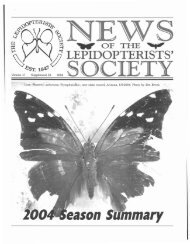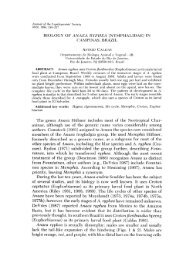HOW TO MAKE REGIONAL LISTS OF BUTTERFLIES - Yale University
HOW TO MAKE REGIONAL LISTS OF BUTTERFLIES - Yale University
HOW TO MAKE REGIONAL LISTS OF BUTTERFLIES - Yale University
You also want an ePaper? Increase the reach of your titles
YUMPU automatically turns print PDFs into web optimized ePapers that Google loves.
VOLUME 33, NUMBER 4 231is harder to document, for individuals of territorial species are nonterritorialpart of the time. Some species occupy territories only atcertain times of the day (such as Vanessa atalanta, in late afternoon).In most territorial species males occupy the territories, and femaleswander in search of them.Life history data such as larval foodplants and adult food sourcesshould be noted. If you rear the early stages you can learn much more.Long observation of an area will often show some transient speciesthat move into an area, live for one or a few seasons, and then die out.At Powdermill, Nastra lherminieri arrived, lasted for several years,then disappeared, and has not been seen since. Both Euptoieta claudiaand Hylephila phyleus established colonies that died out after asingle brood.The Monarch, Danaus plexippus, is a special transient since it regularlymoves into an area in the spring, raises a local brood or two,then emigrates in the fall. The fall southward migration is conspicuousand often spectacular. It is important to keep records of its size,direction, and dates of start and finish. Just as important, however, isthe time of Monarch arrival in the spring, a far less documented eventbecause it is so inconspicuous. One can only note the date of firstspring sighting.Inevitably, long-term observation will produce genuine residentrarities, such as the celebrated Erora laeta, or strays from outside thearea-single individuals of non-resident species.When you have studied an area intensively for several or manyyears you are apt to find significant, non-random changes. They maybe changes in the trend levels of certain populations, but they couldbe other things as well. As succession alters a meadow, grasslandspecies may change from common to rare, or perhaps even disappear;a species not seen before may move in and establish itself, perhapsonly temporarily, perhaps permanently.LITERATURE CITEDCLENCH, H. K. 1949. Regional lists. Lepid. News 3: 15-16.-- 1968. A new butterfly for Powdermill. Powdermill Nature Reserve (CarnegieMus.), Educational Release no. 82: 3 p. [mimeographed].-- 1976. Nathalis iole (Pieridae) in the southeastern United States and the Bahamas.J. Lepid. Soc. 30: 121-126.FIELD, W. D., C. F. DOS PASSOS & J. H. MASTERS. 1974. A bibliography of the catalogs,lists, faunal and other papers on the butterflies of America north of Mexico arrangedby state and province (Lepidoptera: Rhopalocera). Smithsonian Contrib. Zool., no.157: 104 p.KIMBALL, C. P. 1965. The Lepidoptera of Florida. Gainesville (Fla. Dept. Agr., Div.Plant Industry: Arthropods of Florida and Neighboring Land Areas, vol. 1): v +363 p., ill.




